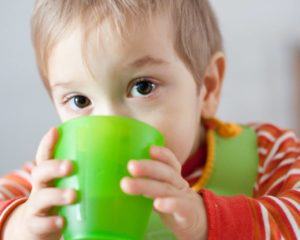Cup Drinking for Infants and Toddlers

When it is time to give up the bottle, many parents struggle with what cup is developmentally appropriate for their children as they grow. There are so many options available on the market, it can be overwhelming. It is also common that children and parents want to hold onto the bottle as long as possible due to the comforts it holds even when this is not developmentally appropriate to continue use of the bottle.
By the time infants turn 6 months, they begin to show interest in cups, especially the ones their parents are drinking from. Infants can begin to drink from an open cup held by an adult as early as 6 months and exploration of the cup should be encouraged. It may be messy and there will be spillage. The bath tub is a fun and inviting solution to the messiness starting cup drinking provides! Allow the child to become messy and learn while getting clean all at the same time. In order for proper oral motor development and growth to occur, it is optimal that infants transition completely off of the bottle by 11-12 months. The earlier practice begins, the increased comfort with an open cup and the easier the transition from bottle to cup will be.
When teaching your young one to drink from an open cup, there are many tips and strategies to help increase success and learning. Start with using a small cup with a small amount of liquid with a soft rim to reduce spilling and encourage proper pacing (i.e. Dixie cup). It is important to allow practice with a variety of cups and avoid hard spout sippy cups. A sippy cup is not a necessary step, however, if you are going to use a sippy cup use one with a soft spout which allows for more challenge and development of oral motor skills. If you need a closed cup due to traveling or fear of spillage, 360 cups and lidded cups are a great option. It allows for development while also providing a way to decrease mess for caregivers. If using a soft spout sippy cup during travels, make sure to practice with open cups at meal and snack times. By 22 months, children are usually able to drink from a cup held with one hand with very little loss of liquid.
Examples of Types of Cups to Try:
Open: Mini or Tiny Cup by EZPZ, Green Sprouts Learning Cup
360: Munchkin 360 cup, Munchkin Splash Toddler Cups with Training Lips
Soft spout sippy cups: Nuby Two Handle iMonster No-Spill Super Spout Cup, Munchkin Latch Transition Cup
Practice cups: Dixie Cups
Teaching Open Cup Drinking:
For open cup drinking, the first thing infants need to learn is how to maintain contact with the cup to their lower tip. Move slowly and allow them time to adjust to liquid flowing into the mouth. When teaching cup drinking, hold the cup to their lip and tip the cup up and down for drinking and pauses while maintaining the contact to the lip rather than taking it away. Encourage practice of jaw stability by holding the edge of the cup with teeth while drinking. In addition, try altering the thickness of the liquid to learn control over the flow rate and management of the liquid within the mouth. Ways to thicken liquids include making smoothies, using baby rice cereal, and artificial Thick It.
Warning Signs:
if your child is coughing following eating and drinking, her or she could be aspirating (breathing in liquid). If you notice this, stop what you are doing and consult your doctor. There are many factors that could be in play including: liquid thickness, liquid flow rate, and swallowing difficulties. You will want to talk options over with your doctor prior to continuing.
If you follow these tips and strategies starting early on, you should have a successful cup drinker on your hands. Have patience! It is a trial and error process, so it may take time.
For more information, visit http://www.abcpediatrictherapy.com
 Skip to content
Skip to content